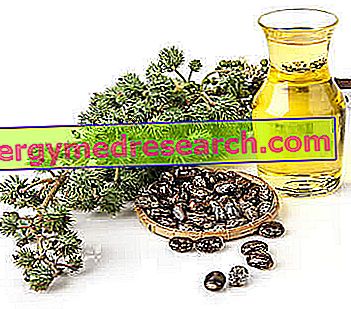Introduction
What are beans?
The beans are starchy seeds enclosed within a pod (fruit), produced from herbaceous plants belonging to the botanical family of the Fabaceae ( Papilionaceae ), better known as leguminous.

As we have said, beans are starchy seeds collected inside a pod, that is the real fruit of the plant. The pod is edible only in the initial phase, while at full maturity it becomes hard and fibrous. The immature beans pods are called green beans and have intermediate nutritional characteristics between those of vegetables and legumes.
Beans today
If for some the beans are extremely useful and valuable foods, others paint them as "junk food".
In the Mediterranean diet, as in the eastern one, beans are an almost irreplaceable nutritional source; they are rich in carbohydrates, proteins, vitamins, minerals, fiber and other nutritional factors. They are easy to grow, they are cheap, they are very easy to keep and are suitable for countless gastronomic associations.
Combined with cereals, vegetables, some fruit, a little milk and an egg from time to time, they are the basis for a balanced vegetarian diet; they also play an essential role in the vegan regime, which however (in the absence of integration) can never be considered totally balanced.
In the omnivorous diet, the beans make it possible to minimize animal foods and preserve the total functionality of the intestine. On the other hand, some modern diets, in addition to denying what has been said so far, believe that beans and other legumes (but also cereals and tubers) are totally useless foods or even sources of unwanted nutritional molecules; among these, carbohydrates stand out, known within the same philosophies as nutrients that make you fat.
In this article we will try to better understand the "truth" about beans.
Nutritional Properties
Nutritional characteristics of beans
Beans are products that belong to the IV fundamental group of foods.
Raw, fresh or frozen, they bring a significant but not excessive amount of energy. Most calories are provided by complex carbohydrates, or starch. An excellent percentage of proteins with a medium biological value follows, lacking in sulfur amino acids (methionine and cysteine), normally integrated through the nutritional association with cereals.
The fats are quantitatively marginal but of good quality, that is basically unsaturated and with a good percentage of essential polyunsaturated fats; among lipids there are other very useful elements such as phytosterols and lecithins.
The fibers are abundant.
Beans contain many B vitamins, such as B1 (thiamine), PP (niacin), folic acid, etc .; they are an excellent source of minerals such as calcium, iron, phosphorus, potassium, etc. They do not provide gluten, lactose or histamine (and do not facilitate release by the body), but may be responsible for allergy. They have no contraindications for favism.
They are foods much consumed in vegetarian and vegan nutritional regimes, even religious or philosophical as Buddhism and Hinduism.
Do they make you fat?
Do beans make you fat?
Beans do not make you fat, although, as with many other foods, too much is too much. Fresh raw beans add 133 kcal / 100 g, dry raw beans 291 kcal / 100 g, cooked beans, canned, drained 91 kcal / 100 g.
The considerable caloricity of the dried seeds is however misleading, since before consumption the beans must be subjected to preliminary soaking, with which they restore the energy density of the fresh raw product.
Once cooked, all types of beans have the same calorific value.
- Also for beans there are precise consumption recommendations, which affect the frequency, as much as the portion. These seeds can be used as a side dish, boiled and possibly seasoned raw or stewed, or as a first course in soup soup, added to minestrone, pastas, risottos, pasta, polenta, etc.
Beans, as legumes, can be eaten 2-3 times a week. The average portion corresponding to: 150 g for those fresh raw or frozen (half a plate, a small drained tin), slightly more for the cooked ones, 50 g for dry beans and flours (2-3 tablespoons).
Excess
Do excess beans make you fat?
Even beans can make you fat.
The excess of calories, especially in the combination of carbohydrates and fats (in this case coming from any seasoning), is responsible for weight gain.
On the other hand, it must be admitted that beans, valued as a food in their own right, are not among the products considered responsible for the growing obesity. Quite the contrary; the statistics indicate that the consumption of legumes is associated with a greater nutritional balance and a weight trend closer to the physiological one compared to overweight.
Beans can be "more problematic" if used in recipes that include large quantities of cereals or other flours, lipid ingredients such as condiments, sausages, fatty cuts of meat, cheeses, etc.
They are very rarely taken in excess in the brothy and plain forms, which on the other hand represent hypocaloric and satiating recipes. It is however a good idea not to overdo it and in the next paragraph we will find out why.
Bean antinutrients
It must be remembered that beans contain a good deal of anti-nutritional molecules.
Made up of chelating agents, such as oxalic acid and phytic acid, but also by enzyme protease inhibitors, the anti-nutritional factors of beans can be totally eliminated after:
- Soaking the dried seeds: during the chemical-physical exchange between the dry seeds and the liquid, the water enters the skin and some molecules come out, for example oxalates and phytates. Alternatively you can choose dehulled seeds.
- Cooking: they are thermolabile molecules and lose their effect when subjected to intense and / or prolonged heat. Note : some nutritional factors, at normal concentrations, have a positive function in the body, such as fibers, tannins and certain polyphenolic antioxidants. However, in excess, these too can reduce nutritional absorption.
The consequences of an excess in anti-nutritional molecules are the lack of generalized absorption (as in the case of fibers) or specific absorption (reduction of calcium due to oxalates, decreased digestion and protein absorption, etc.). Some of these effects are clearly noticeable due to the onset of bloating, abdominal tension, bloating, flatulence and sometimes diarrhea.



